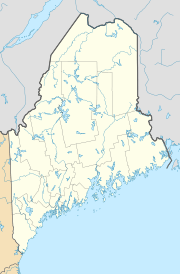Goose River (Medomak River tributary) facts for kids
Quick facts for kids Goose River |
|
|---|---|
|
Location of the mouth of the Goose River in Maine
|
|
| Country | United States |
| State | Maine |
| Counties | Lincoln, Knox |
| Physical characteristics | |
| Main source | Knox County 44°04′54″N 69°17′46″W / 44.08167°N 69.29611°W |
| River mouth | Medomak River Lincoln County 0 m 44°00′47″N 69°21′19″W / 44.01306°N 69.35528°W |
The Goose River is a cool waterway in Maine, a state in the United States. It's like a smaller stream that flows into a bigger river called the Medomak River. This type of smaller river is called a tributary.
The Goose River is about 10.6-mile-long (17.1 km), which is roughly 17 kilometers. It plays a part in the natural environment of Maine.
Contents
Exploring the Goose River
The Goose River is an important part of the local environment in Maine. Rivers like this help shape the land and provide homes for many plants and animals. They also offer places for people to enjoy nature.
Where is the Goose River?
The Goose River is located in the beautiful state of Maine. It flows through two different counties: Knox County and Lincoln County.
Its journey begins in Knox County. From there, it travels south and west. The river eventually reaches its end in Lincoln County. Here, it joins the larger Medomak River. The point where it meets the Medomak River is at sea level.
What is a Tributary?
The Goose River is known as a tributary of the Medomak River. But what exactly does that mean? A tributary is a smaller stream or river that flows into a larger river or lake. Think of it like a branch joining a main tree trunk.
Tributaries are very important. They collect water from a wide area. This water then flows into the main river. This process helps to keep the larger river full and flowing. They also carry nutrients and sediments, which are important for the river's ecosystem.
Why are Rivers Important?
Rivers like the Goose River are vital for many reasons. They provide fresh water for wildlife. Many different kinds of fish, birds, and other animals depend on rivers for their survival. Rivers also create unique habitats along their banks.
Historically, rivers were used for transportation and trade. Today, they are still important for recreation. People enjoy activities like fishing, kayaking, and simply observing nature along riverbanks. Rivers also help shape the landscape over time.


